Special Report
Countries That Suffer the Most From Extreme Weather Events
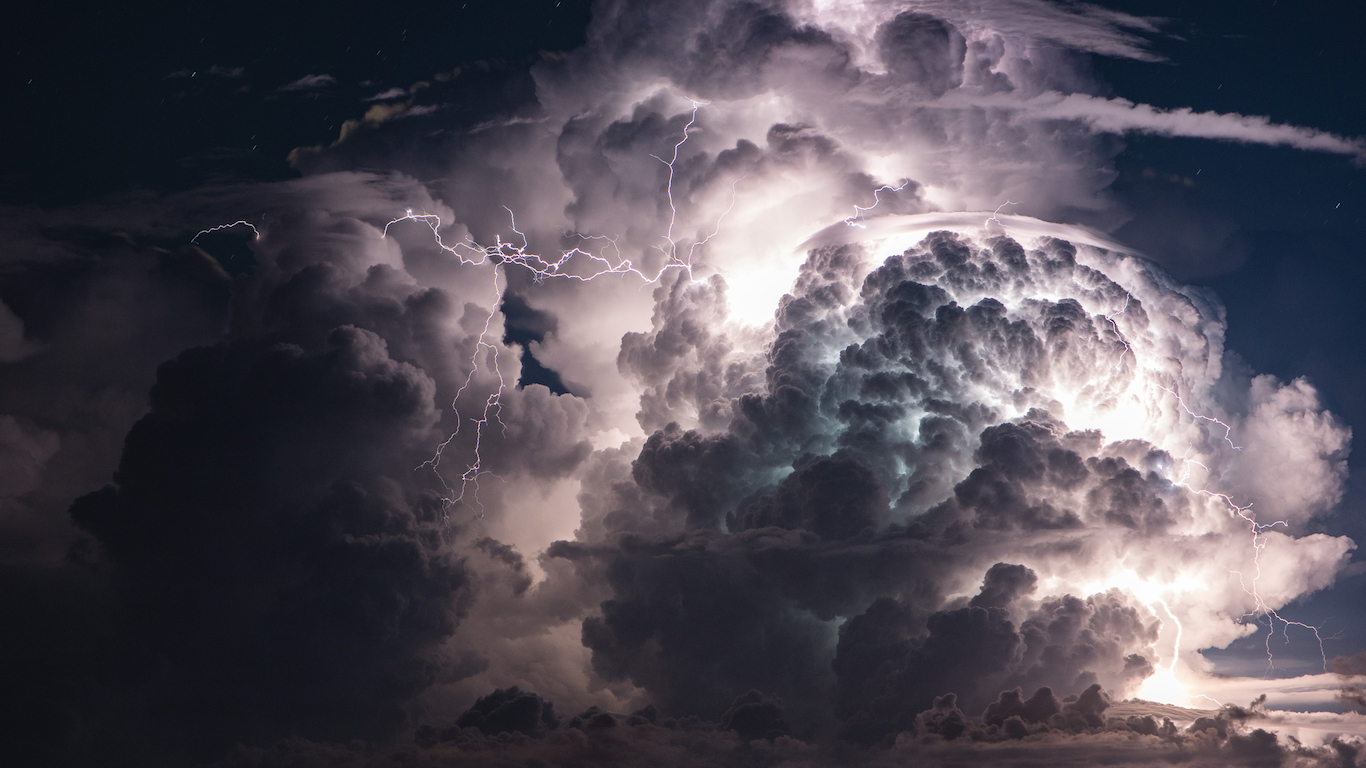
Published:
Last Updated:

For the past 14 years, Germanwatch, an independent development and environmental organization that advocates for sustainable development, has ranked countries by their exposure and vulnerability to climate-related risks over a 20-year period. Called the Climate Risk Index (CRI), the most recent list covers the years between 1998 and 2017.
24/7 Tempo used the CRI to explore the basis for the top 30 rankings and supplemented the underlying data with events that have occurred in the past two years. A single event can quickly move a country to the top of the ranks of disaster-prone places.
According to Germanwatch, in the years covered by the current CRI, more than 526,000 people died from the ravages of 11,500 weather events, with economic losses totalling $3.47 trillion. Some of the poorest countries in the world are among among the ranks of countries most devastated by extreme weather. These countries rank high even though monetary losses, an important factor in the rankings, are much higher in wealthier countries.
For all of the countries listed, climate change is considered a major contributor to the extreme weather events in the past two decades, though it is generally not possible to attribute a particular event to climate change. Big-picture analyses that show storms becoming more frequent and dangerous, temperatures reaching historic extremes, and previously predictable rainfall patterns changing from season to season point to impact from climate change. And the effects of climate change are projected to intensify, causing increasingly costly disasters and loss of life.
Ironically, the poor countries suffering the worst catastrophes are also the countries responsible for the lowest greenhouse gas emissions. Even though they are poor, they are among those trying to improve air and water quality, biodiversity, wastewater treatment, and to reduce carbon emissions — these are the countries that are doing the most (and least) to protect the environment.
Click here to see the countries that suffer the most from extreme weather events
Click here to read our methodology

30. Belize
> Avg. annual fatalities from weather disasters (1998-2017): 2
> Avg. annual losses from weather disasters: $66.15 million
> Population: 383,071
Along with its Central American neighbors, Belize is perennially beset by hurricanes, storms, heavy rainfall, floods, and occasional drought — the country has seen damage or loss of life from more than a dozen powerful storms, including hurricanes, since 1930, eight of which were considered major. Extreme weather events affecting Belize are increasing in frequency and intensity, and its low elevation and coastline also make it vulnerable to sea level rise and storm surges as the climate changes.
[in-text-ad]

29. Oman
> Avg. annual fatalities from weather disasters (1998-2017): 9
> Avg. annual losses from weather disasters: $812.23 million
> Population: 4,829,483
Oman earned its place in the top 30 CRI ranking largely due to the damage wrought by hurricane Gonu in 2007, Oman’s worst natural disaster on record. Gonu was a super cyclonic storm that caused $4 billion in damage and left 49 dead. Other weather trends in Oman are likely attributable to climate change, including increases in temperature and precipitation extremes.

28. Italy
> Avg. annual fatalities from weather disasters (1998-2017): 1,005
> Avg. annual losses from weather disasters: $1.5 billion
> Population: 60,431,283
The appearance of several European countries in the top 30 of the CRI rankings can be attributed largely to the deadly heat waves of 2003, which killed 70,000 people across the continent, including nearly 20,000 in Italy. Heat waves have continued to plague Europe, but other disasters are also escalating. From the regular, foreboding flooding of the grand city of Venice to 2018’s collapse of the annual olive crop — the worst in 25 years — Italy’s most iconic institutions are increasingly devastated by extreme weather.
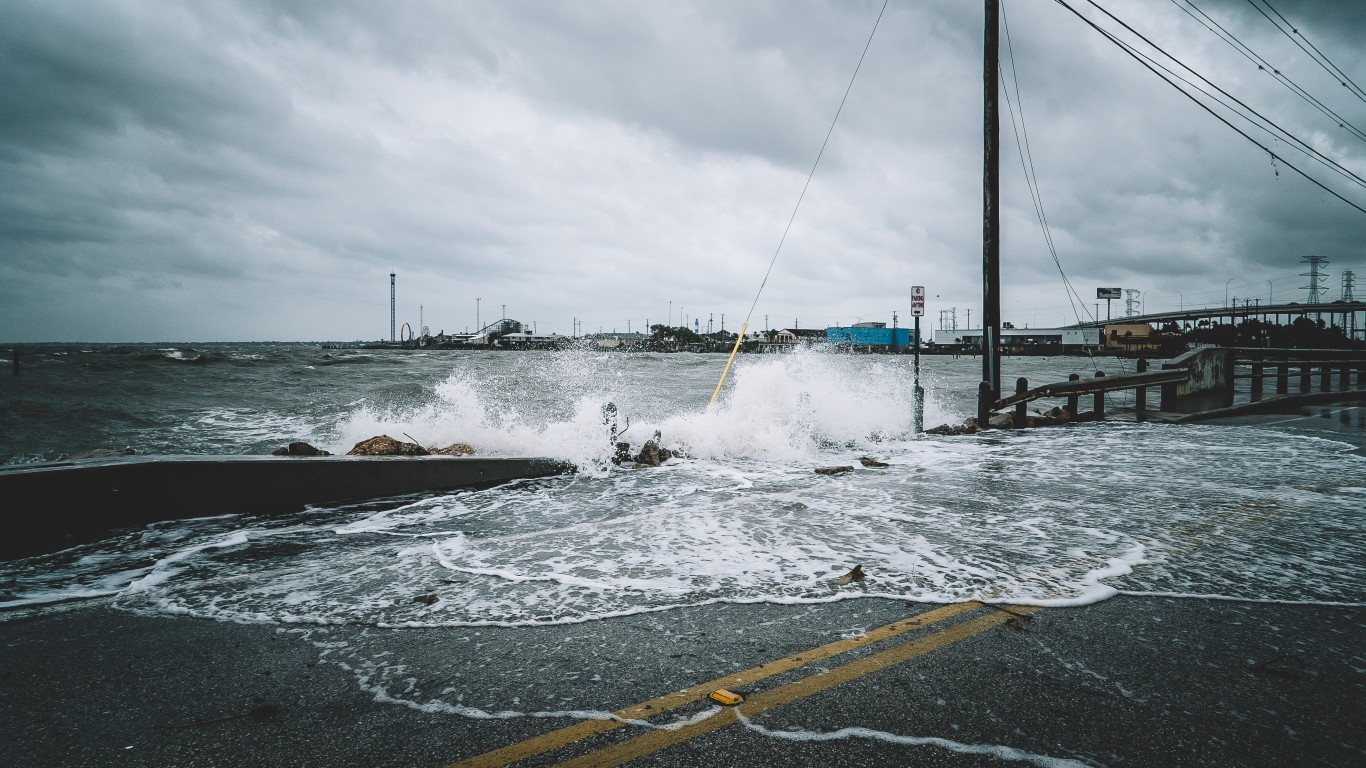
27. United States of America
> Avg. annual fatalities from weather disasters (1998-2017): 451
> Avg. annual losses from weather disasters: $48,658.91 million
> Population: 327,167,434
Like most of the world, the United States is experiencing an increasing number of weather disasters. As tracked by the National Oceanic and Atmospheric Administration’s (NOAA) National Centers for Environmental Information, there were 6.3 such events on average annually between 1980 and 2018, but these skewed heavily toward the last five-year period, during which the annual average was 12.6 events. For the first five months of 2019, NOAA has recorded six “billion-dollar disasters,” including flooding, tornadoes, and storms that produced destructive rain, wind, and hail in regions throughout the country, causing damage to agriculture, homes, businesses, and infrastructure,
[in-text-ad-2]
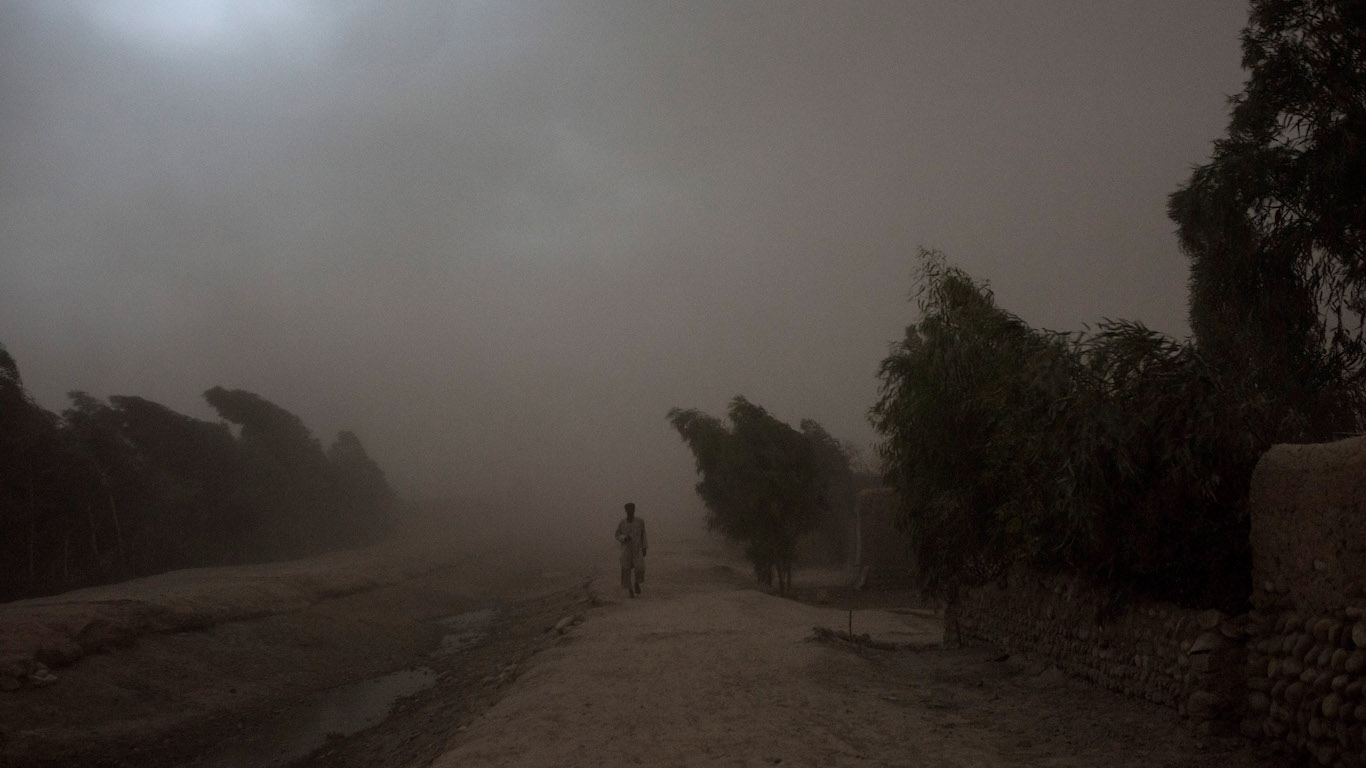
26. Islamic Republic of Afghanistan
> Avg. annual fatalities from weather disasters (1998-2017): 288
> Avg. annual losses from weather disasters: $100.76 million
> Population: 37,172,386
The most serious weather events in Afghanistan, droughts and floods, are threatening its food supply and the livelihood of its citizenry. These events are mainly due to erratic rainfall and snowmelt patterns, which are becoming more irregular due to climate change. Most recently, in March of 2019, the country was devastated by deadly floods that affected millions of people — these floods are not included in the ranking. The flooding followed three years of drought that displaced 266,000 people.
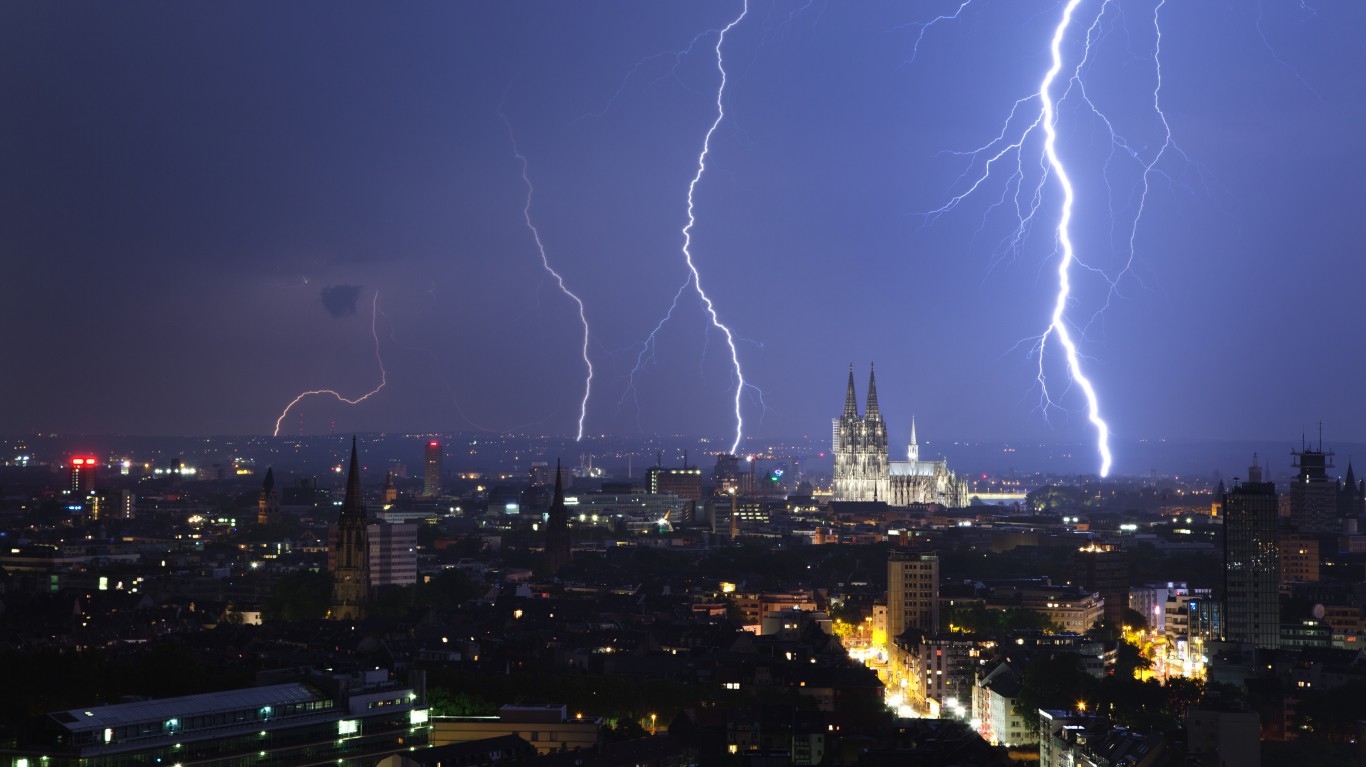
25. Germany
> Avg. annual fatalities from weather disasters (1998-2017): 475
> Avg. annual losses from weather disasters: $3.9 billion
> Population: 82,927,922
After suffering through a year of record drought, which left the Rhine River barely navigable and thousands of farmers seeking emergency aid, Germany received more than its share of rain in the spring of 2019 as a series of dangerous storms delivered torrential rains and flooding, reprising storms that pummeled the country in 2013 and 2017. And there are other reminders that the climate is changing. Germany has also suffered from the extreme heat events that have been plaguing Europe, and the slow depletion of the Alps’ glaciers threaten its rivers.
[in-text-ad]

24. Grenada
> Avg. annual fatalities from weather disasters (1998-2017): 2
> Avg. annual losses from weather disasters: $78.58 million
> Population: 111,454
Historically, Granada has experienced a direct hit from a hurricane every 29.4 years on average, and a major hit every 49 years, but history is changing along with the climate. The last hurricane to severely wallop Grenada, damaging 90% of the housing on the island, was Ivan in September 2004. The island took another direct hit, though much less damaging, from Hurricane Emily the following year. Grenada is considered to be on the front lines of climate change, recently experiencing damaging flooding and coastline erosion from rising sea levels.
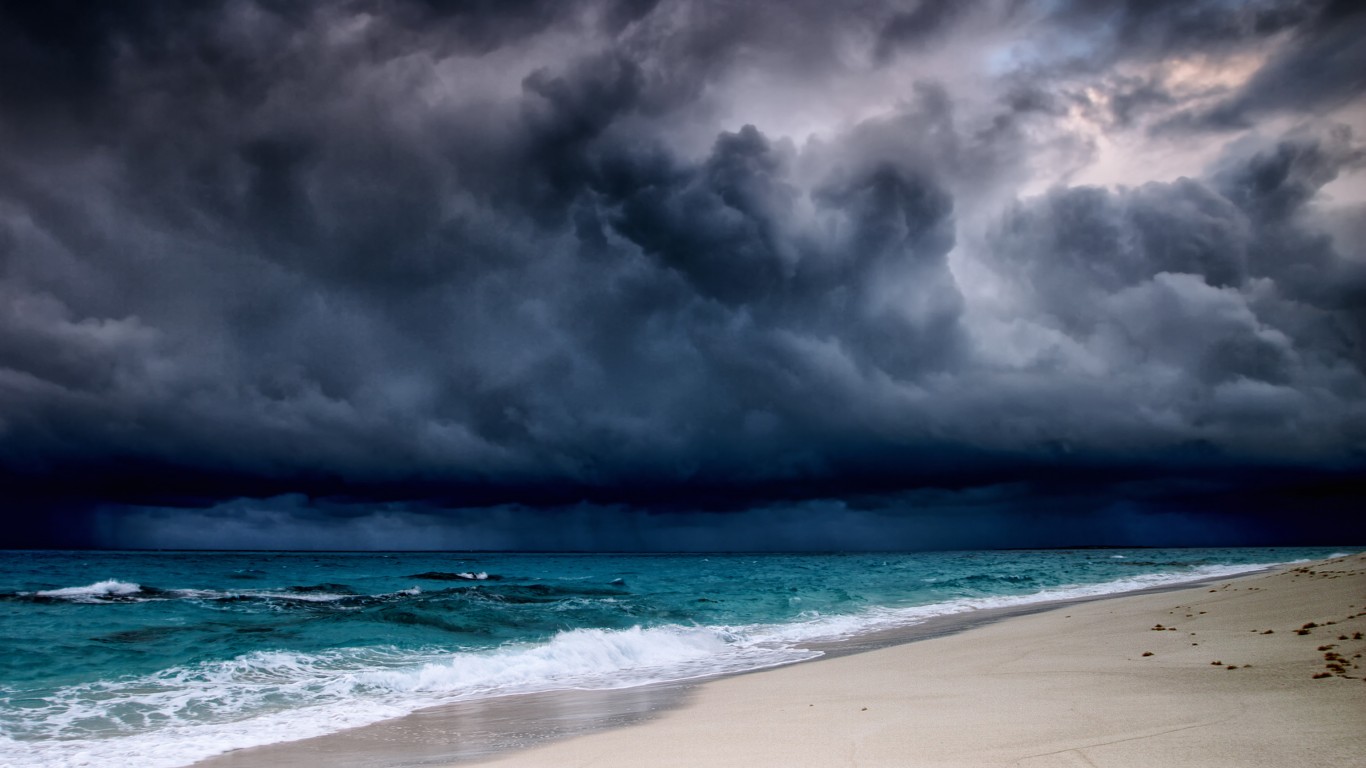
23. The Bahamas
> Avg. annual fatalities from weather disasters (1998-2017): 3
> Avg. annual losses from weather disasters: $207.86 million
> Population: 385,640
A veteran of hurricanes and tropical storms, the Bahamas has a well deserved place on the 2018 CRI. In the wake of this year’s devastation from Hurricane Dorian, which is still being assessed, the islands will certainly move to one of the top spots. With at least 50 dead and 70,000 needing food and shelter, the Bahamas took a direct, slow-moving hit from one of the worst hurricanes on record and the worst natural disaster to ever befall the islands.
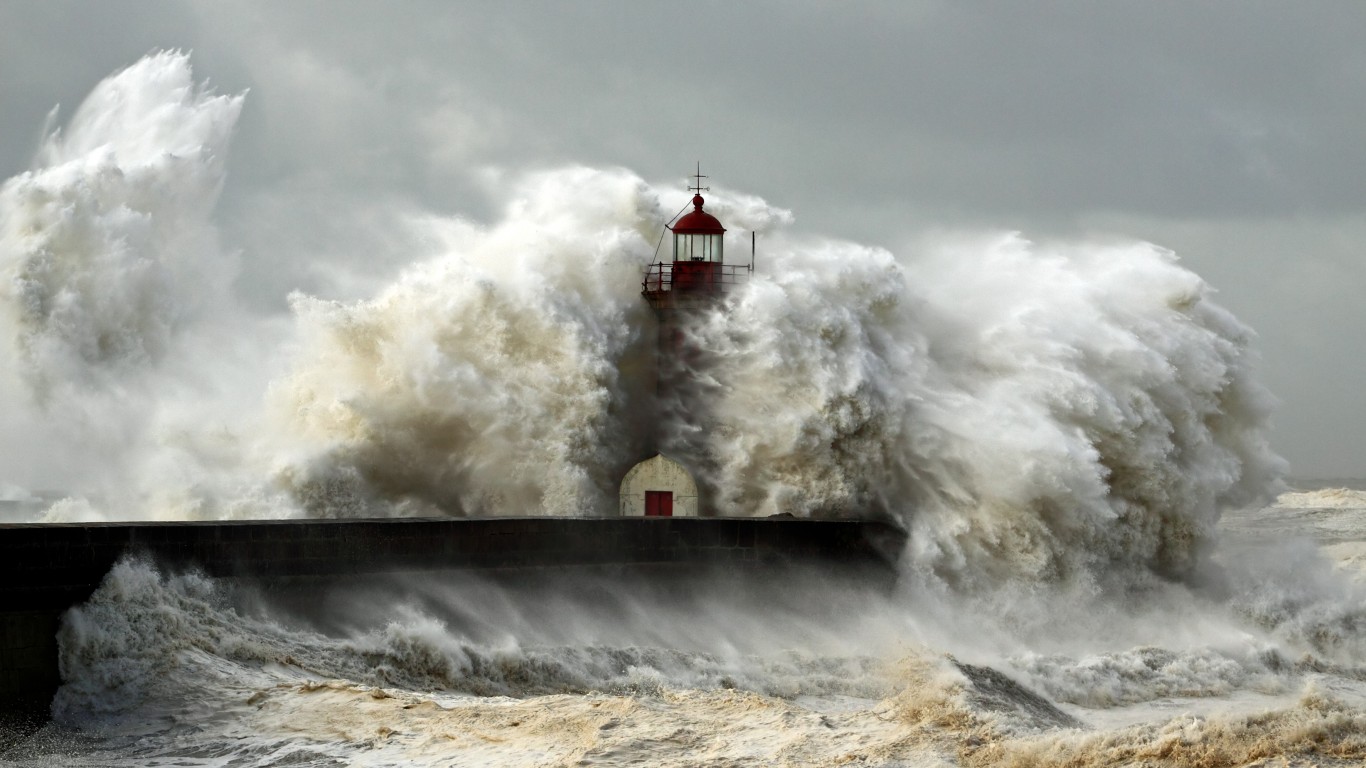
22. Portugal
> Avg. annual fatalities from weather disasters (1998-2017): 147
> Avg. annual losses from weather disasters: $405.57 million
> Population: 10,281,762
Like much of Europe, Portugal has been suffering from blistering summer heatwaves, with its historically highest heat wave events occurring between 1981 and 2010. In 2003, the country’s hottest ever temperature was measured at 117.32 degrees Fahrenheit; 2,000 people died from the heat. Portugal is also believed to be increasingly vulnerable to storms. Only five hurricanes have hit Portugal in its recorded history, the most recent in October of last year, when Hurricane Leslie arrived with winds of over 100 mph. The hurricane uprooted 1,000 trees and blew the roof off a stadium.
[in-text-ad-2]
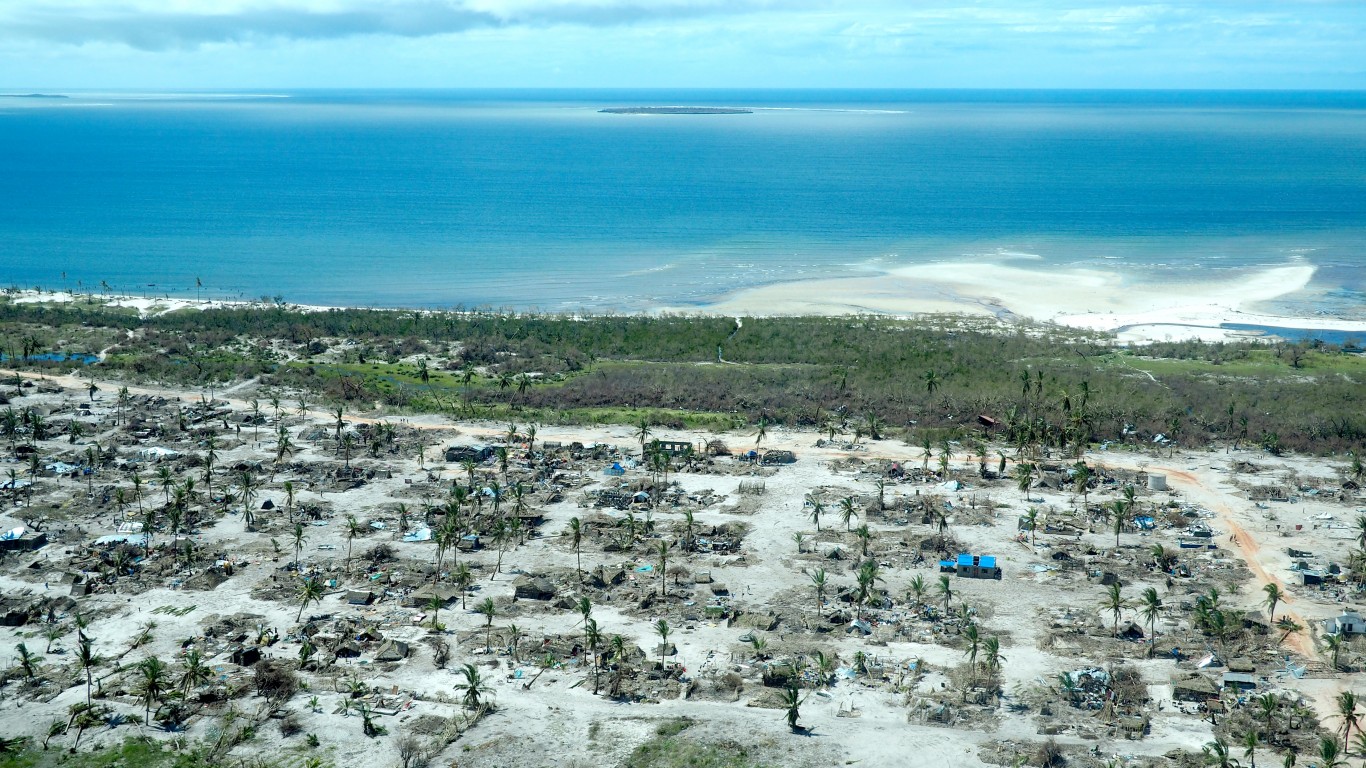
21. Mozambique
> Avg. annual fatalities from weather disasters (1998-2017): 100
> Avg. annual losses from weather disasters: $120.78 million
> Population: 29,495,962
A regular victim of weather extremes, Mozambique is considered particularly vulnerable to climate change. In March of this year, Cyclone Idai ripped through southeastern Africa, killing 598 people, injuring 1,600, and displacing more than 130,000 across the country. Six weeks later, a second cyclone, dubbed Kenneth, killed five people and destroyed nearly 30,000 homes in north Mozambique. Although the country has a history of natural disasters, it had never before been hit by two cyclones in a single season. Mozambique’s river basins, historically prone to flooding, became dangerously swollen, even as nearby communities suffered from drought.
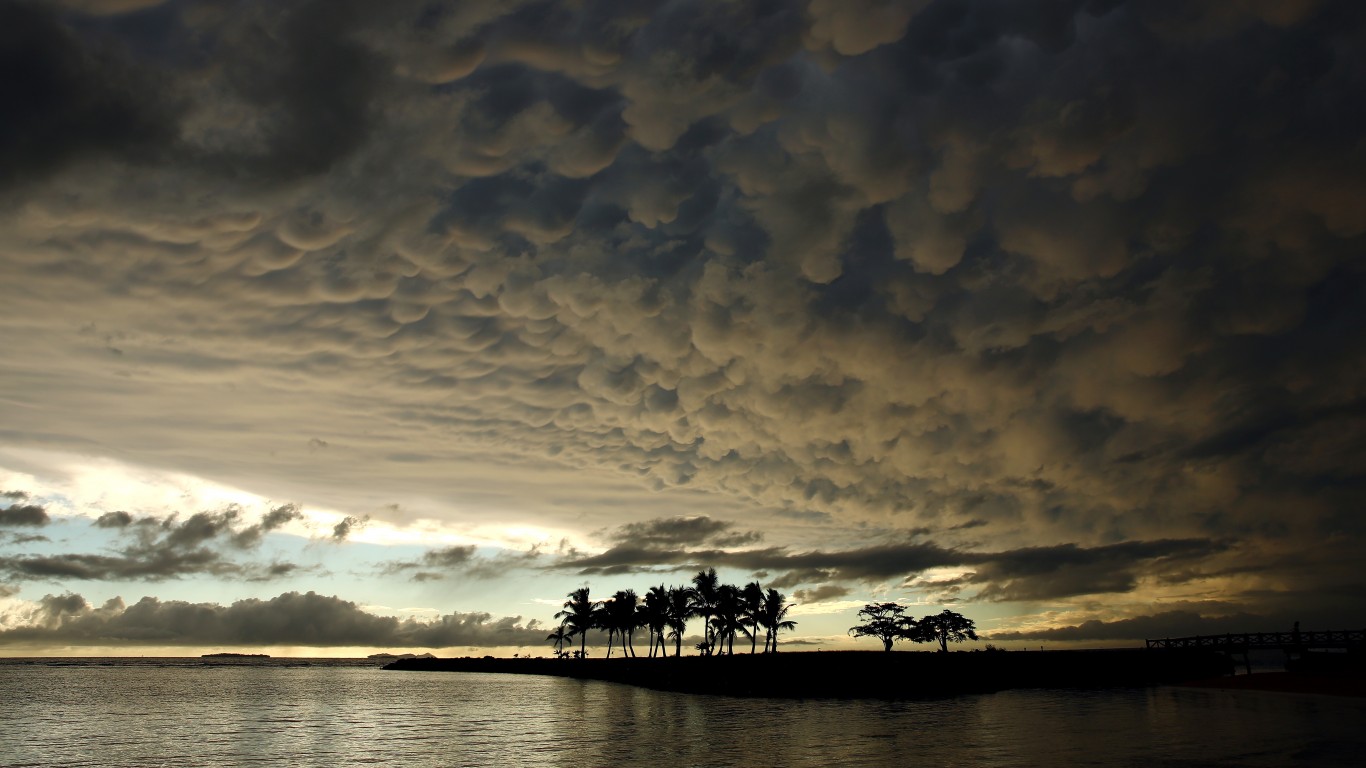
20. Fiji
> Avg. annual fatalities from weather disasters (1998-2017): 7
> Avg. annual losses from weather disasters: $119.98 million
> Population: 883,483
Pummelled by out-of-season cyclones Keni and Josie in 2018 and the deadly category 5 Cyclone Winston in 2016, which killed 41 people and caused $1.4 billion in damage, Fiji is a prominent victim of climate change. The tropical paradise is threatened by increasingly destructive storms, rising temperatures, and increased coastal flooding. Already at least one village has relocated due to rising sea levels.
[in-text-ad]

19. Cambodia
> Avg. annual fatalities from weather disasters (1998-2017): 53
> Avg. annual losses from weather disasters: $242.49 million
> Population: 16,249,798
Like its Southeast Asian neighbors, Cambodia is vulnerable to droughts, tropical storms, heavy rainfall, and floods. In 2009, Typhoon Ketsana caused the death of 43 people and affected 180,000 households. Changes in rainfall patterns and rising temperatures threaten public health, and the country’s food and fresh water supplies.

18. France
> Avg. annual fatalities from weather disasters (1998-2017): 1,121
> Avg. annual losses from weather disasters: $2.2 billion
> Population: 66,987,244
France is experiencing increasingly extreme variations in temperature, suffering from cold snaps in winter and record-breaking heat waves in summer. This year, the country’s wine production is expected to be down by 12% due to late frosts, hailstorms, and extreme heat. Storms that tore through France in June of this year (and are not included in the evaluation) produced damaging hail and destroyed between 80% and 100% of crops in the hardest hit regions. Also in June, France hit a new high temperature of 114.6 degrees Farhenheit, easily beating the previous record of 111.38 degrees measured during a deadly heatwave in 2003, in which thousands were killed. This past summer, two heat waves in June and July were linked to 1,435 deaths in France.

17. Madagascar
> Avg. annual fatalities from weather disasters (1998-2017): 71
> Avg. annual losses from weather disasters: $221.28 million
> Population: 26,262,368
A regular victim of both too-wet and too-dry weather, Madagascar is Africa’s most cyclone-plagued country. Its last tropical storm disasters took place in March 2017 and January 2018. Cyclone Enawo dumped immense quantities of water on denuded slopes, leading to floods and landslides. The disaster killed 81 people and left 270,000 homeless. Cyclone Ava left at least 29 dead and displaced 17,000. Along with increasingly frequent and dangerous storm and rain events, droughts have also become more common. Extreme weather threatens the island’s ecology and agriculture, which is critical to the island’s food supply and labor force.

16. El Salvador
> Avg. annual fatalities from weather disasters (1998-2017): 32
> Avg. annual losses from weather disasters: $277.55 million
> Population: 6,420,744
Like its Central American neighbors, El Salvador regularly experiences a range of weather-related natural disasters such as drought, hurricanes, and landslides. El Salvador’s rainy season — June to November — coincides with hurricane season, so when it rains, there is risk of too much rain. In November of 2009, deadly flooding and landslides initiated a two-year cycle of heavy rains, leaving hundreds dead and thousands homeless. The unprecedented rainfall was followed by two years of drought and a weather-related coffee plant disease. This provided the impetus for many small farmers to emigrate.
[in-text-ad-2]
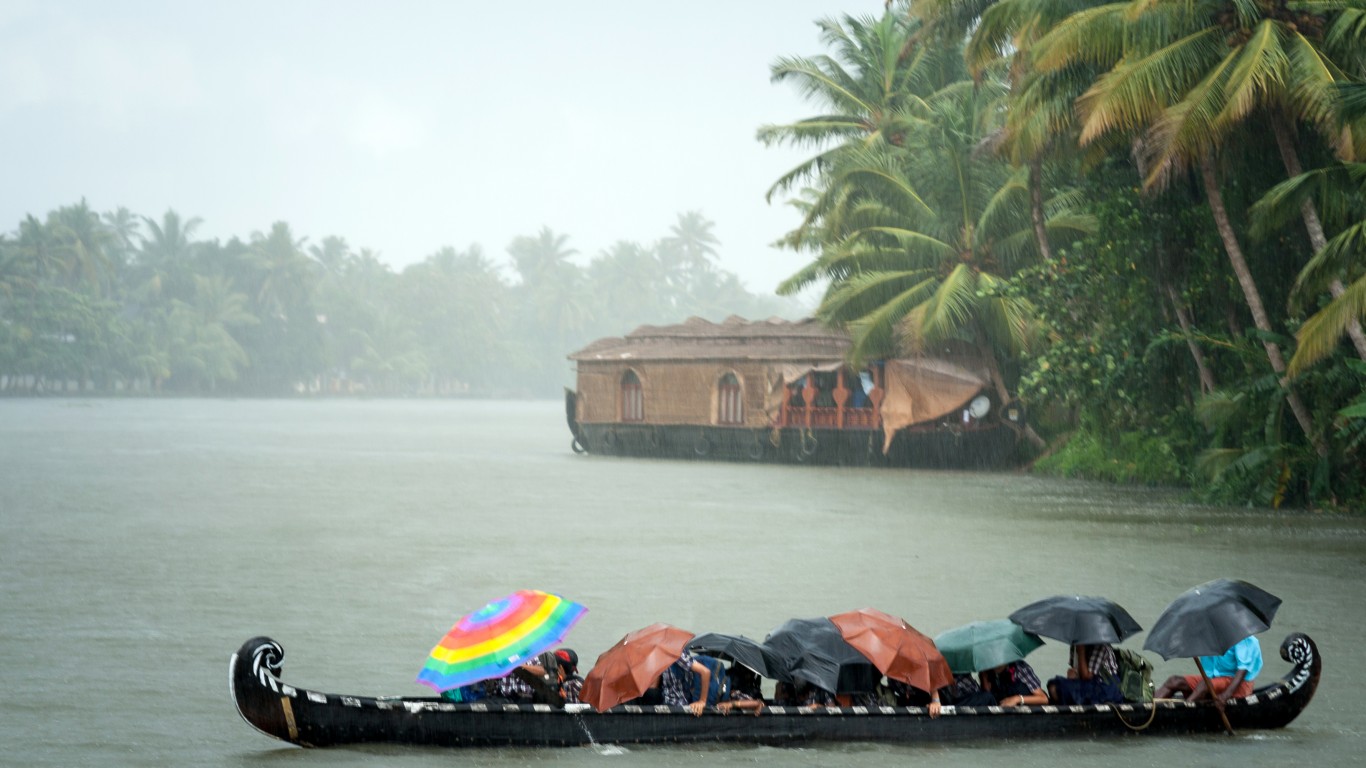
15. India
> Avg. annual fatalities from weather disasters (1998-2017): 3,661
> Avg. annual losses from weather disasters: $12.8 billion
> Population: 1,352,617,328
Extreme weather events are unrelenting in India, afflicting different regions with any number of disasters in a given year: damaging monsoon floods, deadly heat waves, crop destroying droughts and hailstorms, and virulent cyclones. Much of the devastation inflicted on India is shared with the rest of the South Asian region. In the summer of 2017, torrential rainfall in India, Nepal, and Bangladesh led to flooding, landslides, the destruction of tens of thousands of houses, the displacement of millions of people, and the death of 1,200 people.
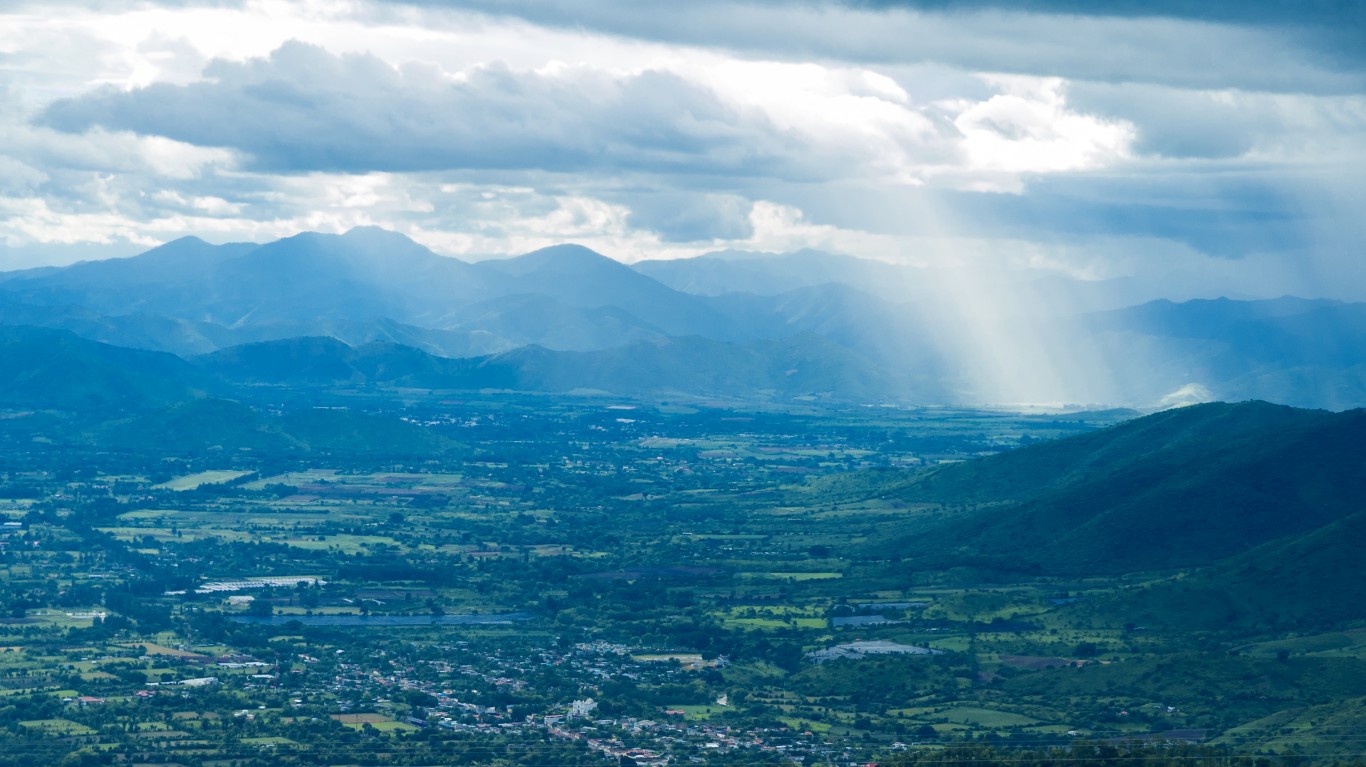
14. Guatemala
> Avg. annual fatalities from weather disasters (1998-2017): 99
> Avg. annual losses from weather disasters: $394.46 million
> Population: 17,247,807
Guatemala has endured more than its share of damaging weather events. In recent years, extreme weather events have become more erratic and extreme, with large fluctuations in temperature and unpredictable rainfall, resulting in both flooding and drought. Ruined crops and loss of economic opportunities resulting from changing weather patterns have particularly afflicted the western highlands region. This environmental and economic disaster has fed the recent migration from Guatemala northward.
[in-text-ad]

13. Thailand
> Avg. annual fatalities from weather disasters (1998-2017): 138
>Avg. annual losses from weather disasters: $7.9 billion
> Population: 69,428,524
Thailand is located in the monsoon region and is subject to extreme weather events, and these are likely to get worse as temperatures have been rising and rain patterns changing over the last 30 years. Thailand regularly experiences flooding during the monsoon season, but in recent years, the country has experienced extreme floods. The flooding is 2011 was ranked as the world’s fourth costliest disaster as of that year, with two-thirds of the country inundated. Another flood in 2016 damaged farmland and affected 360,000 people, killing 14. In 2017, monsoon rains continued into the dry season, causing floods that affected 1.6 million people, killed dozens, and triggered a deadly tidal wave. Since the period covered by the current CRI ranking, 2019 tropical depression Kajiki and tropical storm Podul caused flooding in 32 provinces, killing 28 and damaging 370,749 households.

12. Dominican Republic
> Avg. annual fatalities from weather disasters (1998-2017): 211
> Avg. annual losses from weather disasters: $268.79 million
> Population: 10,627,165
The Dominican Republic is assured a regular spot in the top of the CRI rankings due to its location in the center of the hurricane belt. The northeastern region is also particularly susceptible to storms, flooding, and mudslides, while the northwestern region is subject to an increasing threat of drought.

11. Nepal
> Avg. annual fatalities from weather disasters (1998-2017): 235
> Avg. annual losses from weather disasters: $230.83 million
> Population: 28,087,871
Nepal’s network of 6,000 rivers irrigates the country’s crops but also run havoc on agriculture during the country’s monsoon floods, which also cause damaging landslides and loss of life. In winter months, the primary threat to Nepal’s livability are the frequent droughts and wildfires. An immense monsoon flooding event in August of 2017 affected India, Bangladesh, and Nepal. High rivers in Nepal submerged houses and inundated crop fields — 110 people died in landslides and floodwaters, and thousands were forced from their homes. More recently, and therefore not considered in the lates CRI ranking, monsoon floods and landslides in 2019 killed at least 108 people and submerged villages and houses, displacing 20,273 families.
[in-text-ad-2]
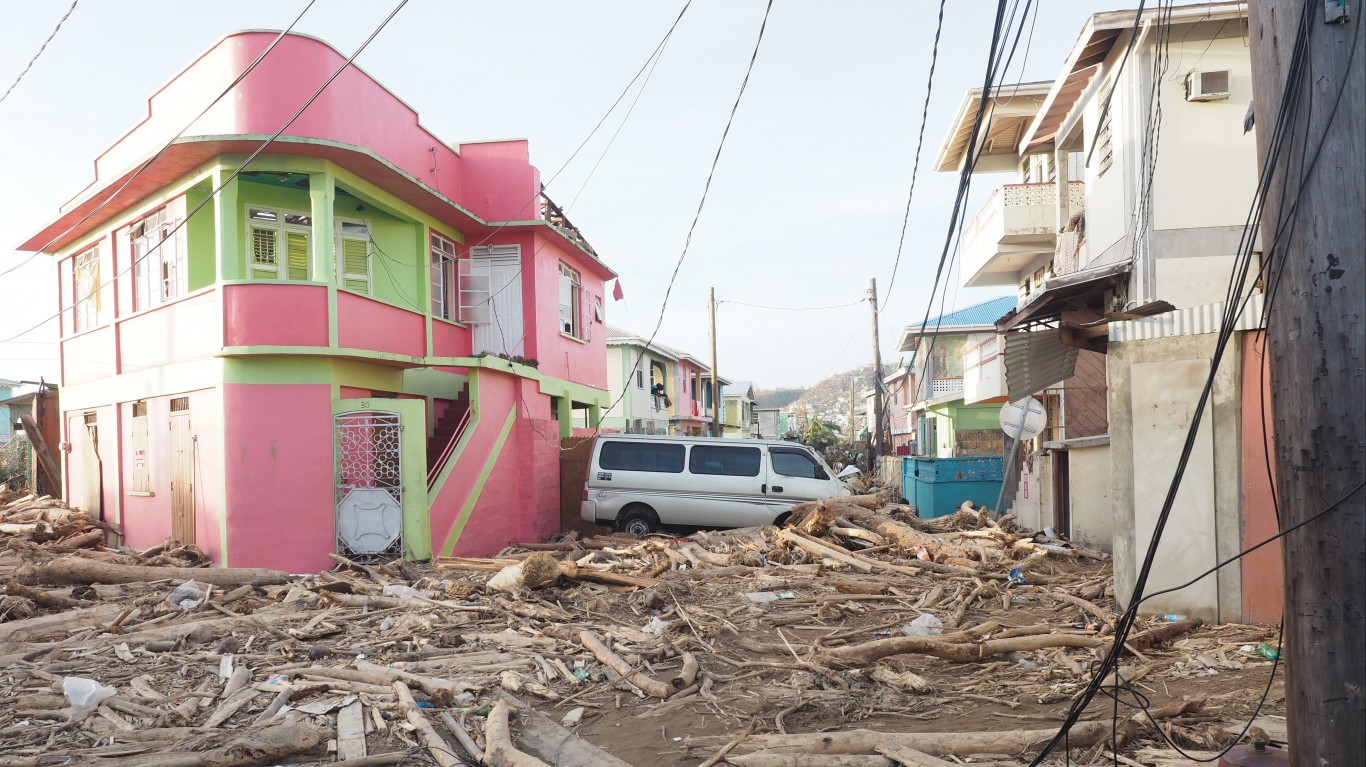
10. Dominica
> Avg. annual fatalities from weather disasters (1998-2017): 3
> Avg. annual losses from weather disasters: $132.59 million
> Population: 71,625
Noted for the devastation it wreaked on Puerto Rico in 2017 as a category 4 hurricane, Hurricane Maria first hit the tiny, mountainous island nation of Dominica as a category 5 hurricane. Maria left thousands of island residents homeless after ripping off 90% of the country’s roofs. During the 20 years of the current CRI ranking, Dominica also suffered damage and loss of life from Hurricane Dean in 2007 and Tropical Storm Erika in 2015.
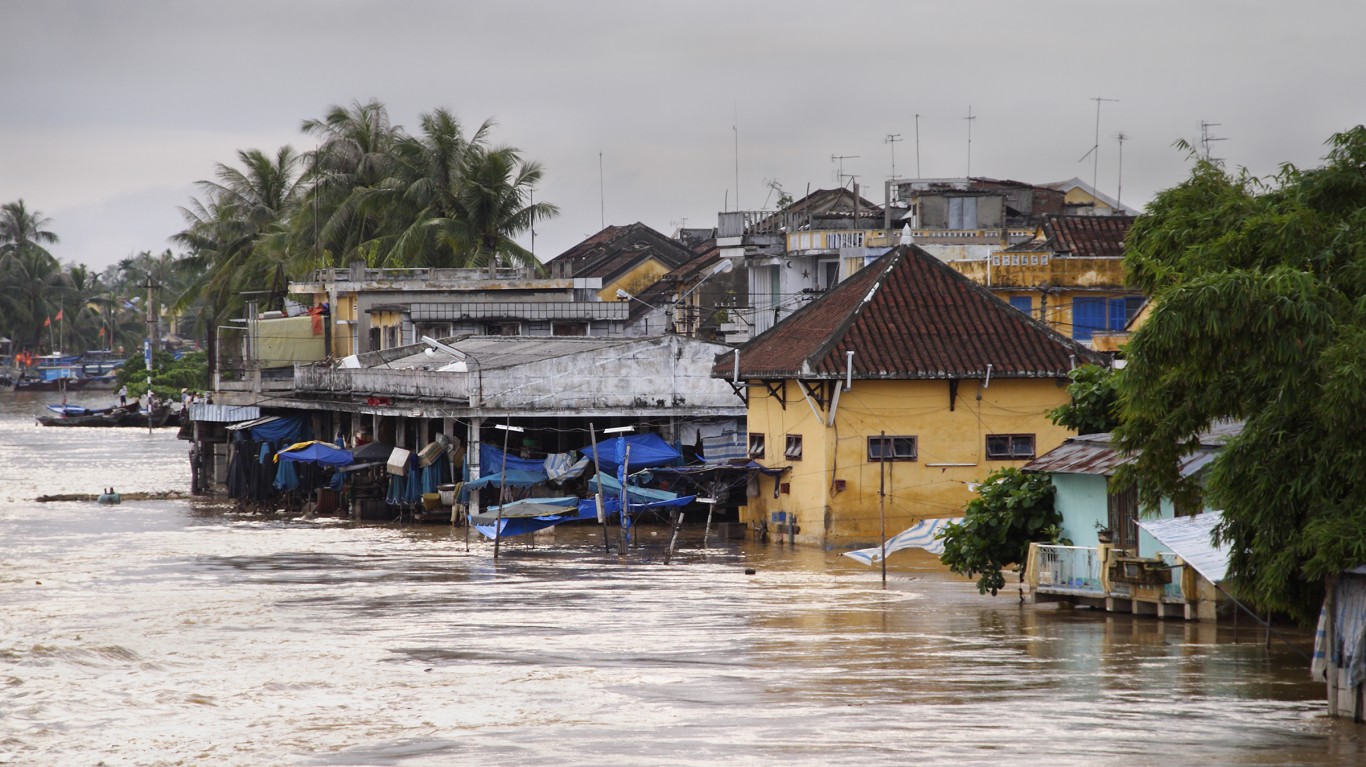
9. Vietnam
> Avg. annual fatalities from weather disasters (1998-2017): 296
> Avg. annual losses from weather disasters: $2.1 billion
> Population: 95,540,395
Vietnam is subject to a range of natural hazards. Most devastating are the frequent and deadly typhoons — six or seven a year on average — and floods, with 70% of the population living on the coast or in low lying river deltas. Vietnam is already seeing the effects of climate change, and these will continue at a more discernible pace than in most of the world: agriculture will suffer from high temperatures; there will be more infrastructure damage from stronger storms; and much of the coastline will be lost to sea-level rise.
[in-text-ad]

8. Pakistan
> Avg. annual fatalities from weather disasters (1998-2017): 512
> Avg. annual losses from weather disasters: $3.8 billion
> Population: 212,215,030
Pakistan is tormented each year by seasonal extremes — drought followed by torrential rain, and extreme heat followed by severe cold waves. The contrast is astounding. In May of 2017, the temperature in Turbat measured 128.7 degrees Farenheit, the fourth highest temperature ever recorded on Earth, yet in February of this year, a heavy rain and snow event left 26 people dead. In April, heavy rain and dust storms killed at least 25 people. These extremes make the country especially vulnerable to the effects of climate change, though it is responsible for less than 1% of the world’s greenhouse gas emissions.

7. Bangladesh
> Avg. annual fatalities from weather disasters (1998-2017): 636
> Avg. annual losses from weather disasters: $2.4 billion
> Population: 161,356,039
Mainly because of its low elevation, Bangladesh has always been vulnerable to extreme weather events — storms, cyclones, drought, landslides, and flooding — but now climate change is intensifying the effects and frequency of weather events and also threatening the country with increasing sea level rise and salinization. Extreme weather over the past three years has displaced tens of millions of people.

6. Nicaragua
> Avg. annual fatalities from weather disasters (1998-2017): 164
> Avg. annual losses from weather disasters: $223.26 million
> Population: 6,465,513
Ten thousand Nicaraguans lost their homes to flooding that resulted from weeks of rain in the spring of 2010. Four years later, another weeklong rain event left nearly 10% of the country under water. It is Nicaragua’s fate to suffer an average of two extreme weather events a year, but the country is also a victim of climate change with storms becoming stronger and more frequent. Nicaragua is only responsible for 0.03% of the world’s greenhouse gas emissions.
[in-text-ad-2]

5. Philippines
> Avg. annual fatalities from weather disasters (1998-2017): 867
> Avg. annual losses from weather disasters: $2.9 billion
> Population: 106,651,922
The Philippines is one of the most disaster-prone countries in the world, suffering from earthquakes and volcanic activity in addition to weather-related events, mainly typhoons, floods, and landslides. The country experiences an average of 19 cyclones a year. One of the deadliest was Typhoon Haiyan (also known as Super Typhoon Yolanda), which came onshore in 2013, killing 6,000 people and displacing millions. Only four years earlier Typhoon Ketsana flooded the country’s capital, Manilla, and caused the deaths of 700 people. The day after Christmas this past winter, storm Usman killed at least 68 people.

4. Haiti
> Avg. annual fatalities from weather disasters (1998-2017): 281
> Avg. annual losses from weather disasters: $418.21 million
> Population: 11,123,176
While a single weather event can markedly elevate a country’s CRI status in a given year, Haiti, like the Philippines, is perennially and reliably among the most weather devastated places in the world, and the devastation is exacerbated by the country’s extreme poverty. Haiti suffers from multi-year droughts, as it did from 2012 to 2015, and is threatened annually by hurricanes. Hurricane Mathew in 2016 killed 800 people and left 806,000 requiring emergency food assistance. These weather events impaired Haiti’s ability to recover from a different kind of natural disaster, a 2010 earthquake that killed a still unknown number of people, possibly as many as 316,000.
[in-text-ad]

3. Myanmar
> Avg. annual fatalities from weather disasters (1998-2017): 7,049
> Avg. annual losses from weather disasters: $1.3 billion
> Population: 53,708,395
In a country prone to earthquakes, storm surges, floods, and landslides, a single disaster, Cyclone Nargis in 2008, is responsible for Myanmar’s high ranking. With Nargis, the worst natural disaster in Myanmar’s history, 140,000 people lost their lives. The cyclone was responsible for 95% of all damage experienced and fatalities in the past two decades.
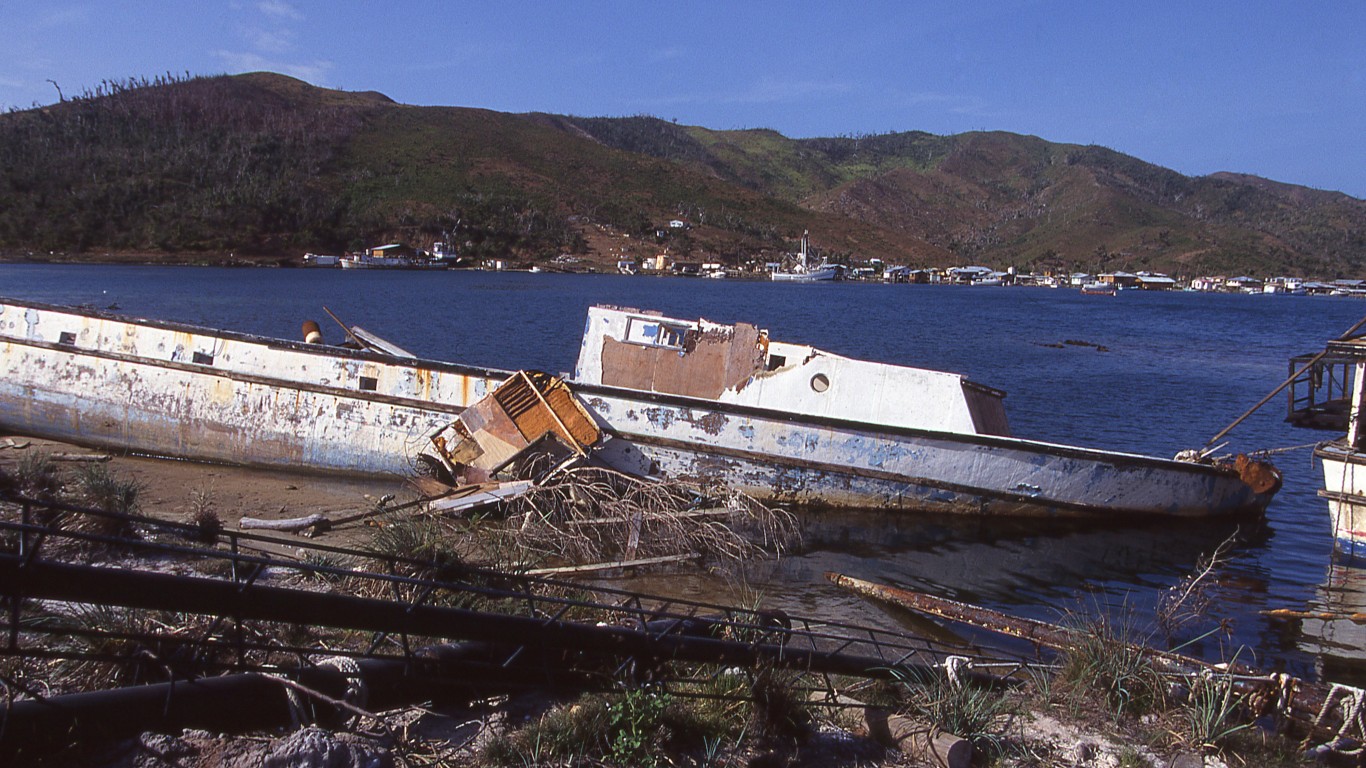
2. Honduras
> Avg. annual fatalities from weather disasters (1998-2017): 302
> Avg. annual losses from weather disasters: $556.56 million
> Population: 9,587,522
Honduras is particularly vulnerable to a range of weather disasters, including storms, floods, and drought. It earned its current high CRI ranking thanks to the damage 1998 Hurricane Mitch wrought, the second deadliest Atlantic hurricane on record at the time. The country experienced 180 mile-an-hour winds as the hurricane made landfall, with total rainfall ranging from 30 to 50 inches as the storm moved slowly inland. The flooding, mudslides, and winds destroyed infrastructure, crops, and population centers. Fatalities attributed to Mitch exceeded 11,000 across Central America and Mexico, with thousands of people missing.

1. Puerto Rico
> Avg. annual fatalities from weather disasters (1998-2017): 150
> Avg. annual losses from weather disasters: $5.0 billion
> Population: 3,195,153
Puerto Rico rose to the top of the list of countries most affected by extreme weather following the devastation wrought by Hurricane Maria in 2017. A class 4 hurricane when it blasted across the island, Maria took lives and property, caused extreme flooding and mudslides, and cut 100% of the country’s electricity. The initial official estimate of 64 hurricane-related deaths has been greatly expanded since and is now believed to be closer to 3000, including deaths caused by loss of medical services.
Methodology
To determine which countries suffer the most from extreme weather, 24/7 Tempo reviewed the Climate Risk Index (CRI) scores assigned to 181 countries by Germanwatch’s “Global Climate Risk Index 2019.” Average fatalities and average losses in millions of dollars between the years 1998 and 2017 also came from the 2019 CRI.
In creating the CRI, Germanwatch used data from the Munich Re NatCatSERVICE, one of the most reliable sources of worldwide data on natural catastrophes, to analyze impacts of extreme weather events, particularly in terms of fatalities and economic losses. Germanwatch examined both absolute and relative impacts to create an average ranking of countries. The CRI does not provide an all-encompassing analysis of the risks of anthropogenic climate change, but according to its authors, should be seen as just one analysis explaining countries’ exposure and vulnerability to climate-related risks.
Credit card companies are pulling out all the stops, with the issuers are offering insane travel rewards and perks.
We’re talking huge sign-up bonuses, points on every purchase, and benefits like lounge access, travel credits, and free hotel nights. For travelers, these rewards can add up to thousands of dollars in flights, upgrades, and luxury experiences every year.
It’s like getting paid to travel — and it’s available to qualified borrowers who know where to look.
We’ve rounded up some of the best travel credit cards on the market. Click here to see the list. Don’t miss these offers — they won’t be this good forever.
Thank you for reading! Have some feedback for us?
Contact the 24/7 Wall St. editorial team.